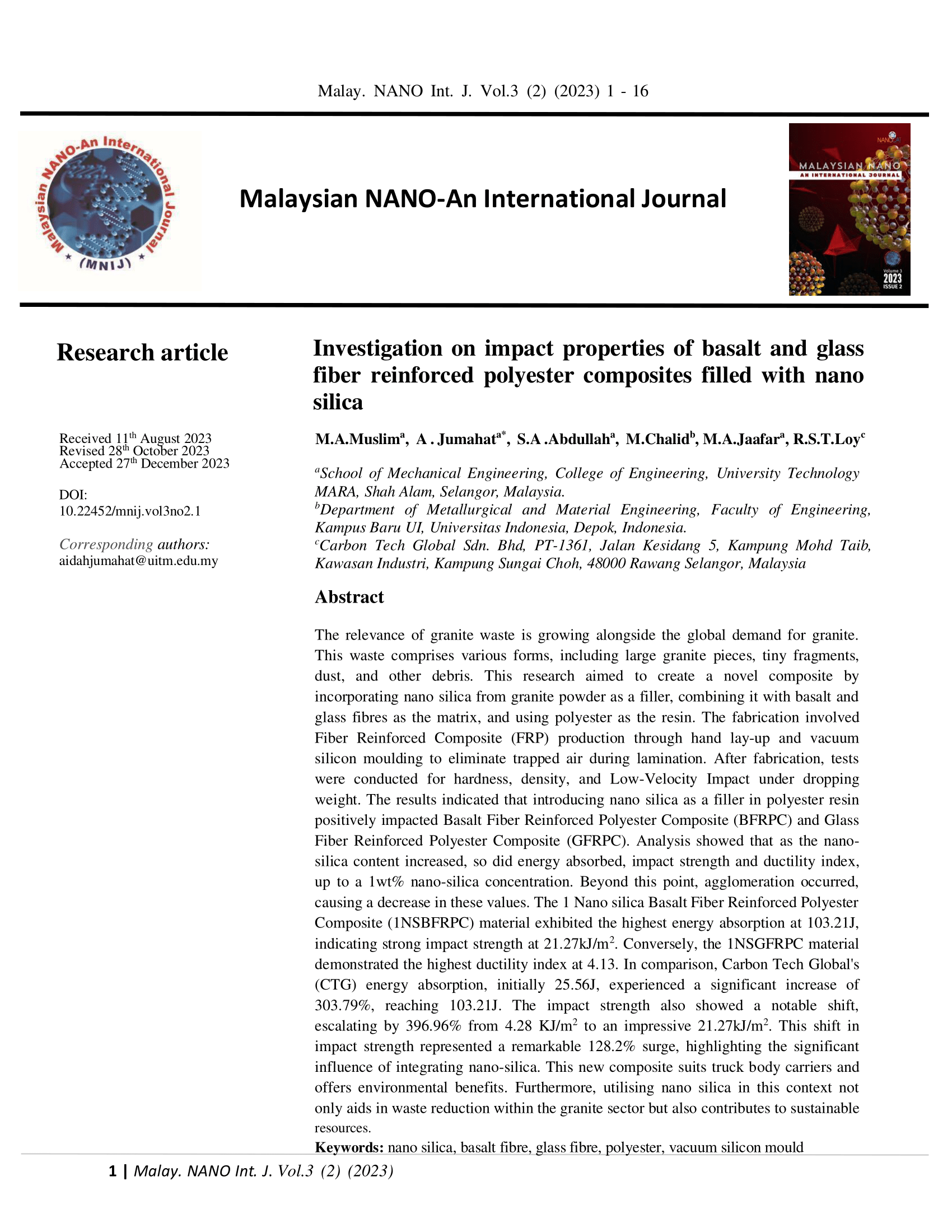Investigation on impact properties of basalt and glass fiber reinforced polyester composites filled with nano silica
DOI:
https://doi.org/10.22452/mnij.vol3no2.1Keywords:
nano silica, basalt fibre, glass fibre, polyester, vacuum silicon mouldAbstract
The relevance of granite waste is growing alongside the global demand for granite. This waste comprises various forms, including large granite pieces, tiny fragments, dust, and other debris. This research aimed to create a novel composite by incorporating nano silica from granite powder as a filler, combining it with basalt and glass fibres as the matrix, and using polyester as the resin. The fabrication involved Fiber Reinforced Composite (FRP) production through hand lay-up and vacuum silicon moulding to eliminate trapped air during lamination. After fabrication, tests were conducted for hardness, density, and Low-Velocity Impact under dropping weight. The results indicated that introducing nano silica as a filler in polyester resin positively impacted Basalt Fiber Reinforced Polyester Composite (BFRPC) and Glass Fiber Reinforced Polyester Composite (GFRPC). Analysis showed that as the nano-silica content increased, so did energy absorbed, impact strength and ductility index, up to a 1wt% nano-silica concentration. Beyond this point, agglomeration occurred, causing a decrease in these values. The 1 Nano silica Basalt Fiber Reinforced Polyester Composite (1NSBFRPC) material exhibited the highest energy absorption at 103.21J, indicating strong impact strength at 21.27kJ/m2. Conversely, the 1NSGFRPC material demonstrated the highest ductility index at 4.13. In comparison, Carbon Tech Global's (CTG) energy absorption, initially 25.56J, experienced a significant increase of 303.79%, reaching 103.21J. The impact strength also showed a notable shift, escalating by 396.96% from 4.28 KJ/m2 to an impressive 21.27kJ/m2. This shift in impact strength represented a remarkable 128.2% surge, highlighting the significant influence of integrating nano-silica. This new composite suits truck body carriers and offers environmental benefits. Furthermore, utilising nano silica in this context not only aids in waste reduction within the granite sector but also contributes to sustainable resources.
Downloads
References
A. Raju and M. Shanmugaraja, “Recent researches in fiber reinforced composite materials: A review,” in Materials Today: Proceedings, Elsevier Ltd, 2019, pp. 9291–9296. doi: 10.1016/j.matpr.2020.02.141.
M. Noryani, S. M. Sapuan, and M. T. Mastura, “Multi-criteria decision-making tools for material selection of natural fibre composites: A review,” Journal of Mechanical Engineering and Sciences, vol. 12, no. 1. Universiti Malaysia Pahang, pp. 3330–3353, Mar. 01, 2018. doi: 10.15282/jmes.12.1.2018.5.0299.
A. S. Nascimento et al., “Production of plaster mortar with incorporation of granite cutting wastes,” J Clean Prod, vol. 265, 2020, doi: 10.1016/j.jclepro.2020.121808.
N. Zainuddin, N. Z. Mohd Yunus, M. A. M. Al-Bared, A. Marto, I. S. H. Harahap, and A. S. A. Rashid, “Measuring the engineering properties of marine clay treated with disposed granite waste,” Measurement (Lond), vol. 131, pp. 50–60, Jan. 2019, doi: 10.1016/j.measurement.2018.08.053.
L. Gautam, J. K. Jain, P. Kalla, and M. Danish, “Sustainable utilisation of granite waste in the production of green construction products: A review,” in Materials Today: Proceedings, Elsevier Ltd, 2020, pp. 4196–4203. doi: 10.1016/j.matpr.2020.10.532.
D. C. Kumar, P. Vasanthi, and A. Devaraju, “Experimental studies on composite bricks using black cotton soil, fly ash and granite waste,” Mater Today Proc, vol. 39, pp. 868–874, 2020, doi: 10.1016/j.matpr.2020.10.663.
A. Fathy, A. Shaker, M. A. Hamid, and A. A. Megahed, “The effects of nano-silica/nano-alumina on fatigue behavior of glass fiber-reinforced epoxy composites,” J Compos Mater, vol. 51, no. 12, pp. 1667–1679, May 2017, doi: 10.1177/0021998316661870.
K. Khan, W. Ahmad, M. N. Amin, and S. Nazar, “Nano-Silica-Modified Concrete: A Bibliographic Analysis and Comprehensive Review of Material Properties,” Nanomaterials, vol. 12, no. 12. MDPI, Jun. 01, 2022. doi: 10.3390/nano12121989.
S. Mahović Poljaček, D. Priselac, T. Tomašegović, U. S. Elesini, M. Leskovšek, and M. Leskovac, “Effect of the Addition of Nano-Silica and Poly(ε-caprolactone) on the Mechanical and Thermal Properties of Poly(lactic acid) Blends and Possible Application in Embossing Process,” Polymers (Basel), vol. 14, no. 22, Nov. 2022, doi: 10.3390/polym14224861.
X. Hou, S. Yao, Z. Wang, C. Fang, and T. Li, “Enhancement of the mechanical properties of polylactic acid/basalt fiber composites via in-situ assembling silica nanospheres on the interface,” J Mater Sci Technol, vol. 84, pp. 182–190, 2021, doi: 10.1016/j.jmst.2021.02.001.
P. S. Krishna Kumar and B. Navin Kumar, “Improvement of impact strength of novel intra-ply basalt/kevlar composite by addition of silica nanoparticles in comparison with basalt/kevlar composite using resin transfer mould process,” Mater Today Proc, vol. 69, pp. 843–847, Jan. 2022, doi: 10.1016/j.matpr.2022.07.272.
R. H. Abdel-Rahim, M. S. Attallah, and R. A. Mohammed, “Investigation the Effect of Nano Silica Dioxide Additives on the Properties of Epoxy Resin for Using in Industrial Applications,” Materials Science Forum, vol. 1050 MSF, pp. 103–113, 2022, doi: 10.4028/www.scientific.net/MSF.1050.103.
N. A. Bhalla, H. Chouhan, R. K. Yadav, and N. Bhatnagar, “Exploring the Effect of Dispersed Phase on the High Strain Rate Mechanical Response of Nanosilica Dispersions,” IOP Conf Ser Mater Sci Eng, vol. 1248, no. 1, p. 012073, Jul. 2022, doi: 10.1088/1757-899x/1248/1/012073.
C. Zhang, Z. Tang, B. Guo, and L. Zhang, “Concurrently improved dispersion and interfacial interaction in rubber/nanosilica composites via efficient hydrosilane functionalisation,” Compos Sci Technol, vol. 169, pp. 217–223, Jan. 2019, doi: 10.1016/j.compscitech.2018.11.016.
W. Alnahhal and O. Aljidda, “Effect of Fiber Volume Fraction on Behavior of Concrete Beams Made with Recycled Concrete Aggregates,” MATEC Web of Conferences, vol. 253, p. 02004, 2019, doi: 10.1051/matecconf/201925302004.
P. Srinivas Manikanta, Ms. Chowdary, M. Niranjan kumar, P. Student, and A. Professor, “Effect of Nano Silica on the Tensile Property of Woven Banana and S-glass Fiber Reinforced Hybrid Polyester Composites,” 2018. [Online]. Available: www.jetir.org
N. Shaari and A. Jumahat, “Unhole and open hole compressive behaviours of hybrid Kevlar/glass fibre reinforced silica nanocomposites,” Mater Res Express, vol. 5, no. 6, p. 65009, 2018, doi: 10.1088/2053-1591/aac667.
M. A. Muslim, A. Jumahat, S. A. Abdullah, M. A. Jaafar, N. Sapiai, and R. S. Teng Loy, “Investigation on impact properties of different type of fibre form: Hybrid hemp/glass and kenaf/glass composites,” Physical Sciences Reviews, 2022, doi: 10.1515/psr-2022-0053.
S. S. Yao, F. L. Jin, K. Y. Rhee, D. Hui, and S. J. Park, “Recent advances in carbon-fiber-reinforced thermoplastic composites: A review,” Composites Part B: Engineering, vol. 142. Elsevier Ltd, pp. 241–250, Jun. 01, 2018. doi: 10.1016/j.compositesb.2017.12.007.
N. E. Nor, A. Mohammad, A. Jumahat, and A. Arthur, “Effect of Silica Nanoparticles on Quasi-Static Indentation and Impact Properties of Glass Fibre Reinforced Epoxy Polymer Composites,” 2018. [Online]. Available: www.sciencepubco.com/index.php/IJET
J. Jensin Joshua, D. Singh, P. S. Venkatanarayanan, C. S. Snehit, A. Bipin Sai Eswar, and M. Desta, “Experimental Estimation of Energy Absorbed and Impact Strength of Kevlar/Basalt-Epoxy Interwoven Composite Laminate Added with Al2O3Nanoparticles after High-Velocity Bullet Impact,” Journal of Engineering (United Kingdom), vol. 2023, 2023, doi: 10.1155/2023/2830575.
P. S. Krishna Kumar and B. Navin Kumar, “Improvement of impact strength of novel intra-ply basalt/kevlar composite by addition of silica nanoparticles in comparison with basalt/kevlar composite using resin transfer mould process,” Mater Today Proc, vol. 69, pp. 843–847, Jan. 2022, doi: 10.1016/j.matpr.2022.07.272.
V. V. Galishnikova, P. C. Chiadighikaobi, and D. A. Emiri, “Comprehensive view on the ductility of basalt fiber reinforced concrete focus on lightweight expanded clay,” Structural Mechanics of Engineering Constructions and Buildings, vol. 15, no. 5, pp. 360–366, 2019, doi: 10.22363/1815-5235-2019-15-5-360-366.
M. A. Jaafar, S. A. Abdullah, A. Jumahat, M. A. Muslim, N. Sapiai, and R. S. T. Loy, Effect of stacking sequence on tensile properties of glass, hemp and kenaf hybrid composites. 2023. doi: 10.1515/psr-2022-0052.
R. N. Raja Othman, D. K. Subramaniam, N. Ezani, M. F. Abdullah, and K. Z. Ku Ahmad, “The Synergistic Effects of Hybrid Micro and Nano Silica in Influencing the Mechanical Properties of Epoxy Composites—A New Model,” Polymers (Basel), vol. 14, no. 19, Oct. 2022, doi: 10.3390/polym14193969.
F. Ruan, W. Hao, X. Chenglong, Y. Qingyong, Z. Lihua, and X. Zhenzhen, “Bending and Impact Performance of Kevlar/Basalt Fabric Interlayer Hybrid Curved Composites,” 2022, doi: 10.21203/rs.3.rs-1889862/v1.

Downloads
Published
How to Cite
Issue
Section
License





